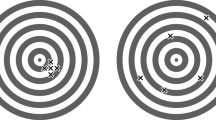Abstract
Savage denied that Bayesian decision theory applies in large worlds. This paper proposes a minimal extension of Bayesian decision theory to a large-world context that evaluates an event \(E\) by assigning it a number \(\pi (E)\) that reduces to an orthodox probability for a class of measurable events. The Hurwicz criterion evaluates \(\pi (E)\) as a weighted arithmetic mean of its upper and lower probabilities, which we derive from the measurable supersets and subsets of \(E\). The ambiguity aversion reported in experiments on the Ellsberg paradox is then explained by assigning a larger weight to the lower probability of winning than to the upper probability. However, arguments are given here that would make anything but equal weights irrational when using the Hurwicz criterion. The paper continues by embedding the Hurwicz criterion in an extension of expected utility theory that we call expectant utility.
Similar content being viewed by others
Notes
European roulette has no 00. Bets on low or high remain on the table when 0 occurs.
Vitali’s argument needs the Axiom of Choice, without which all sets on the circle can be taken to be Lebesgue measurable (assuming “inaccessible cardinals” exist—Solovay 1970). But to deny the Axiom of Choice would seem to deny the ethos that led Savage to insist on the relevance of large worlds by assuming that our current formalism is adequate to describe anything that nature might throw at us.
His theorem has a countable set of exceptional points, but the later work of Banach and Tarski perfected his result on the way to proving their even more spectacular paradox.
All limits in Postulate 3 are taken from within \(D\). If \((0,0)\) were excluded from the set \(D\), the theorem would fail as \(v(x,y)=x^{1-\alpha }y^{\alpha }\) would remain a possibility.
\(f(x+y)=f(x)+f(y)\) implies \(f'(x+y)=f'(x)\). So \(f'(y)=f'(0)\) and \(f(y)=f'(0)y\).
The identity does not hold if \(E\) is unmeasured and \({\alpha }\not ={1 \over 2}\), because
 implies that \(1=(1-{\alpha })p+{\alpha }P + (1-{\alpha })(1-P)+{\alpha }(1-p) = 1+(2\alpha -1)(P-p)\), where \(p\) and \(P\) are the lower and upper probabilities of \(E\).
implies that \(1=(1-{\alpha })p+{\alpha }P + (1-{\alpha })(1-P)+{\alpha }(1-p) = 1+(2\alpha -1)(P-p)\), where \(p\) and \(P\) are the lower and upper probabilities of \(E\).Postulate 9 does not even imply that a gamble can be identified with \({\mathcal{P}}\) when all the prizes are \({\mathcal{P}}\). But when \(\mathcal{M}\not =\emptyset \) and so \(B\) is a measured event, this conclusion follows from requiring that Bayesian decision theory holds for gambles constructed only from measured events.
Note that we are asking more than that \(\pi \) be a measure on \(\mathcal{M}\). In particular, although our standard normalization of VN&M utility functions ensures that \(\pi (\emptyset )=0\) and \(\pi (B)=1\) and so \(\pi \) is always a measure on \(\{\emptyset , B\}\), it need not be true that \(\{\emptyset , B\}\subseteq \mathcal{M}\). Example 5 is a case in which \(\mathcal{M}\) is taken to be empty (Sect. 2.1).
References
Anscombe, F., & Auman, R. (1963). A definition of subjective probability. Annals of Mathematical Statistics, 34, 199–205.
Arrow, K. (1971). Essays on the theory of risk bearing. Chicago: Markham.
Arrow, K., & Hurwicz, L. (1972). An optimality criterion for decision-making under ignorance. In C. Carter & J. Ford (Eds.), Uncertainty and expectations in economics. Oxford: Basil Blackwell.
Binmore, K. (2005). Natural justice. New York: Oxford University Press.
Binmore, K. (2009). Rational decisions. Princeton: Princeton University Press.
Chernoff, H. (1954). Rational selection of decision functions. Econometrica, 22, 422–443.
Ghirardato, P., Maccheroni, F., Marinacci, M. (2002). Ambiguity from the differential viewpoint. Social Science Working Paper 1130.
Gillies, D. (2000). Philosophical theories of probability. London: Routledge.
Good, I. J. (1983). Good thinking: The foundations of probability and its applications. Minneapolis: University of Minnesota Press.
Halmos, P. (1950). Measure theory. Princeton: Van Nostrand.
Halpern, J., & Fagin, R. (1992). Two views of belief: Belief as generalized probability and belief as evidence. Artificial Intelligence, 54, 275–3178.
Hurwicz, L. (1951). Optimality criteria for decision making under ignorance. Cowles Commission Discussion Paper, Statistics 370.
Keeney, R., & Raiffa, H. (1975). Additive value functions. In J. Ponssard, et al. (Eds.), Theorie de la decision et applications. Paris: Fondation national pour L’Eneignment de la Gestion des Enterprises.
Klibanoff, P., Marinacci, M., & Mukerji, S. (2005). A smooth model of decision-making under ambiguity. Econometrica, 73, 1849–1892.
Luce, R., & Raiffa, H. (1957). Games and decisions. New York: Wiley.
Manski, C. (2013). Public policy in an uncertain world. Cambridge, MA: Harvard University Press.
Milnor, J. (1954). Games against nature. In R. Thrall, C. Coombs, & R. Davies (Eds.), Decision processes. New York: Wiley.
Savage, L. (1954). The foundations of statistics. New York: Wiley.
Schmeidler, D. (1989). Subjective probability and expected utility without additivity. Econometrica, 57, 571–585.
Schmeidler, D. (2004). Subjective probability and expected utility without additivity. In I. Gilboa (Ed.), Uncertainty in economic theory: Essays in honor of David Schmeidler’s 65th birthday. London: Routledge.
Shackle, G. (1949). Expectation in economics. Cambridge: Cambridge University Press.
Solovay, R. (1970). A model for set theory in which every set of real numbers is Lebesgue measurable. Annals of Mathematics, 92, 1–56.
Suppes, P. (1974). The measurement of belief. Journal of the Royal Statistical Society, 2, 160–191.
Wagon, S. (1985). The Banach-Tarski paradox. Cambridge: Cambridge University Press.
Widder, D. (1941). The Laplace transform. Princeton: Princeton University Press.
Acknowledgments
I am grateful for funding from the European Research Council under the European Community’s Seventh Framework Programme (FP7/2007-2013)/ERC grant 295449. I am also grateful to David Kelsey and Karl Schlag for commenting on a previous version of the paper.
Author information
Authors and Affiliations
Corresponding author
Rights and permissions
About this article
Cite this article
Binmore, K. A minimal extension of Bayesian decision theory. Theory Decis 80, 341–362 (2016). https://doi.org/10.1007/s11238-015-9505-0
Published:
Issue Date:
DOI: https://doi.org/10.1007/s11238-015-9505-0





 implies that
implies that